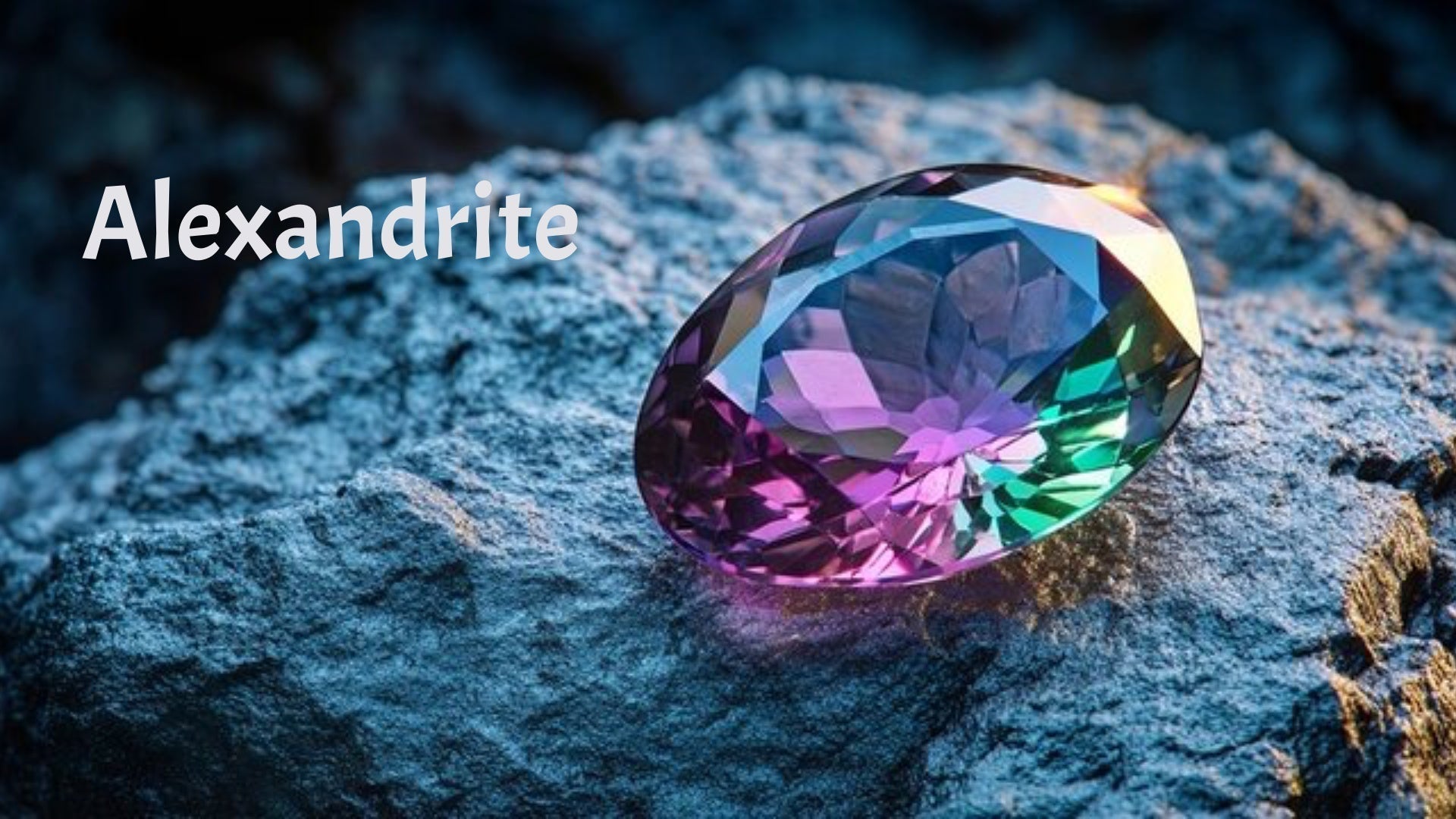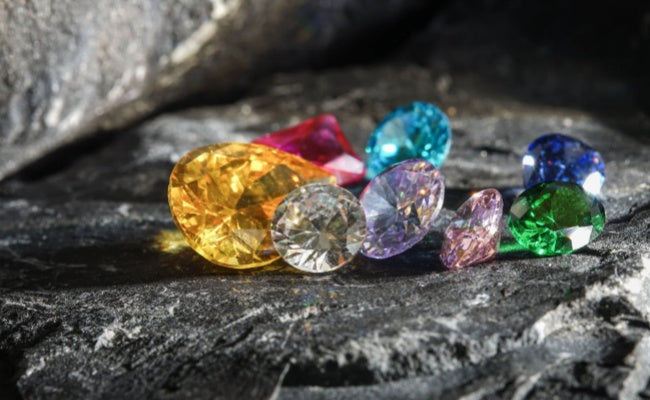
What is Alexandrite? The Ultimate Guide to Alexandrite Stone
Among the many colorful gemstones, alexandrite stands out for its unique color-changing property. As one of the Jun birthstones and the 55th Anniversay gemstone, alexandrite captivates the attention of gem enthusiasts and collectors alike.
This article dives deep into the formation, characteristics, history, significance, and buying guide of alexandrite gemstones to help you gain a comprehensive understanding of this magical gem. Whether you are a gem collector, jewelry designer, or simply someone intrigued by color-change gems, this detailed alexandrite guide will offer you valuable insights.
What is Alexandrite?
Alexandrite belongs to the chrysoberyl family, with the chemical formula beryllium aluminum oxide (BeAl₂O₄). It scores 8.5 on the Mohs hardness scale, which is quite high, making it durable and suitable for long-term wear in jewelry.
Other Physical Properties
- Mohs Hardness: 8.5, just behind diamond (10) and corundum (9), offering excellent scratch resistance.
- Refractive Index: 1.746–1.755
- Density: 3.73 g/cm³
- Cleavage: No obvious cleavage, with a shell-like fracture
- Luster: Ranges from glassy to subadamantine

What Color is Alexandrite?
Alexandrite stone is often called the "chameleon of the gemstone world" and ranks among the rarest and most expensive gems globally. It's famous for its remarkable ability to change color under different lighting. In daylight, alexandrite stone usually shows a bluish-green or green hue, while under incandescent light, it shifts to red or purplish-red. This striking color-change phenomenon is known as the "Alexandrite Effect" in gemology.
The secret behind alexandrite's color shift lies in the chromium ions (Cr³⁺) in its crystal structure. These chromium ions act like "color filters" inside the gem, selectively absorbing and reflecting different wavelengths of light to create its distinct visual effect. Essentially, the colors we see are the light wavelengths reflected by the stone and perceived by our eyes, which change depending on the light source.
For instance, sunlight during the day contains a balanced spectrum of colors but is richer in blue light, which is why the sky looks blue. Under sunlight, alexandrite gemstone absorbs red and yellow wavelengths and mainly reflects blue-green. In contrast, incandescent light (traditional light bulbs) has more red and yellow light and less blue, giving it a warm yellowish quality. Under this light, alexandrite gemstone reflects red hues because it lacks sufficient blue light to reflect the blue-green color, making the gem appear raspberry or purplish-red. Edwin W. Streeter once described it as "an emerald by day, a ruby by night", perfectly capturing this gem's unique allure.
Moreover, the clarity and cut of alexandrite stones are crucial. Higher transparency allows more light to pass through the stone, enhancing the visibility of its color change, while excellent cutting highlights the gem's brilliance and optimizes light interaction to fully showcase its color-shifting marvel.
How is the Alexandrite's Color Change Quality Rated?
Professional gemologists assess alexandrite quality based on its "color change intensity":
- Excellent (100% color change): Shows completely different colors under various light sources, for example, shifting from pure bluish-green to pure red with a strong contrast. This is top-tier alexandrite stone.
- Good (75-99% color change): Noticeable color change but might include some secondary hues under certain lights, such as shifting from bluish-green to purplish-red with strong contrast.
- Medium (50-74% color change): Clear color change with moderate contrast, for instance shifting from green to brownish-red.
- Weak (25-49% color change): Subtle color change, mostly slight tonal shifts.
- Very Weak (less than 25% color change): Almost no color change, with relatively low value.

The History of Alexandrite
In the 1830s, near the Tokovaya River in Russia's Ural Mountains, miners were extracting emerald stones. At that time, a Finnish mineralogist named Nils Gustaf Nordenskiöld was examining newly mined gems. Because these stones appeared a deep green in daylight, he initially mistook them for emeralds.
But then something magical happened! When workers looked at the stones again by candlelight and oil lamps at night, they were amazed to see the gems turn red! At first, people thought it was an illusion or that different stones had been mixed up. However, after repeated tests, they confirmed that it was indeed the same gem showing different colors under different lighting conditions. This color-changing phenomenon led Nordenskiöld to name the stone "diaphanite".
In 1834, a Russian mining chief, Count Lev Alexeyevich Perovsky, who had provided Nordenskiöld with the alexandrite gem sample, gifted the stone to the future Tsar Alexander II's on his 16th birthday and named it "Alexandrite". This is how the gem got its name.
It was an even greater coincidence that the two main colors of alexandrite stone — green and red — matched Russia’s national colors. This was seen as a good omen, symbolizing that the future tsar would bring prosperity and glory to Russia.
In the 19th century, alexandrite stones quickly became one of the most treasured gems of the Russian royal family. Members of the royal court believed this color-shifting stone symbolized adaptability and balance, bringing good luck and wisdom to those who wore it.
The outbreak of the Russian Revolution in 1917 dramatically changed the fate of alexandrite gemstones. With the fall of the tsarist regime, lots of royal jewelry were confiscated, auctioned off, or scattered worldwide with exiled nobility. Although this was a regrettable historical event, it also objectively helped spread alexandrite across the globe. European collectors and jewelers began to acquire this remarkable gem, and its fame expanded beyond Russia.
Where is Alexandrite Found?
Russia's Ural Mountains
As the original source of alexandrite, the gems from Russia's Ural Mountains are considered the highest quality. These stones display the most intense color changes, shifting from blue-green to cherry red, with rich, vibrant colors. However, after nearly 200 years of mining, the deposits here are nearly depleted, causing the price of Russian Alexandrite to soar.
Minas Gerais, Brazil
In the 1980s, significant alexandrite deposits were found in Brazil. Brazilian Alexandrite generally has lighter colors and more subtle color changes but compensates with higher production volume, offering more options in the market. Typical Brazilian Alexandrite shifts from yellow-green to orange-red.
Sri Lanka
Alexandrite from Sri Lanka is renowned for its excellent clarity and good color change. These stones are usually very transparent, with fewer inclusions, and take a bright shine when cut. Their colors typically shift from blue-green to purplish red.

Other Sources
Besides the main origins, natural alexandrite stone is also found in places like Madagascar, Tanzania, and Myanmar, though in smaller quantities. Gems from these regions each have unique characteristics, providing collectors with more diverse choices.
How Rare is Alexandrite?
Alexandrite entered the market after being discovered in Russia’s Ural Mountains. However, after nearly 200 years of mining, the reserves of high-quality natural Russian Alexandrite have nearly been depleted. Today, although alexandrite deposits are found worldwide, their limited supply keeps prices high, making them unaffordable for most people.
As one of the rarest gemstones in the world, the scarcity of natural alexandrite can be understood through these facts:
Compared to diamonds:
- Diamonds have an annual production of about 130 million carats, whereas natural alexandrite’s yearly output is less than 1,000 carats.
- Alexandrite is over 100,000 times rarer than diamonds.
Compared to other colored gemstones:
- Rubies and sapphires have annual productions in the tens of thousands of carats.
- Emeralds have annual productions in the thousands of carats.
- Alexandrite’s production is less than 1,000 carats, with high-quality specimens being even scarcer.
Within the already extremely rare Alexandrite category, truly top-quality stones are exceptionally scarce:
- High-quality natural alexandrites over 5 carats? The world sees fewer than 10 per year.
- Stones with strong color-change effects make up less than 5% of total production.
- Top-quality Russian Alexandrite is nearly extinct.
Lab-Grown Alexandrite Stones
Because natural alexandrite is expensive and scarce, gemologists have turned their focus to lab-grown chrysoberyl. Lab-grown alexandrite is created by mimicking the natural formation environment in laboratories using advanced techniques such as the floating zone method, flux melting, hydrothermal synthesis, and chemical vapor deposition. Though synthetic, these lab-created alexandrite stones share the exact chemical makeup and crystal structure of natural alexandrite, explaining their similar texture, durability, and properties.

Differences Between Lab-Grown and Natural Alexandrite
The biggest difference between natural and lab-grown alexandrite lies in their inclusions. Natural alexandrite forms over millions of years under geological processes, making every stone unique with natural inclusions like needle-like or liquid inclusions, and highly varied textures. In contrast, lab-grown alexandrite is produced in controlled environments, resulting in fewer inclusions, often appearing as bubbles or curved growth patterns. Additionally, the intensity of the color-change effect in lab-grown stones can be controlled.
While natural alexandrite stone takes thousands of years to form, lab-grown alexandrite can be produced in weeks or months. Due to its rarity and complex formation, natural alexandrite holds much higher market value and collector appeal. Though lab-grown alexandrite is cheaper and can be produced on demand, it is still more costly than the natural ones.
As technology advances, the line between lab-created and natural alexandrite becomes increasingly blurred, offering consumers a variety of choices to fit different tastes and budgets. LUO Jewelry offers alexandrite rings, necklaces, and earrings — all made with lab-created alexandrite stone that shifts color from bluish-green to purple, with quality and characteristics comparable to natural stones. We warmly invite you to explore our alexandrite jewelry collection and discover the pieces that express your unique style.
Alexandrite Stone Meanings
Alexandrite is highly treasured for its unique color-changing property. It is widely believed to bring luck and positive energy to relationships, love, strength, and romance.
What does alexandrite symbolize?
Due to its ever-changing colors, alexandrite symbolizes balance, adaptability, and transformation. It represents the wisdom of maintaining one's true essence in different environments, while flexibly responding to change and showing diverse facets. This meaning resonates deeply with today's fast-paced life, reminding us to keep inner peace amid chaos, strive for work-life balance, and face change with optimism.
The two main colors of the stone — red and green — carry complementary and profound symbolism: red signifies passion and vitality, while green represents tranquility and nourishment. Their harmonious blending illustrates the unity of life’s energy and renewal. This color combination is not only visually pleasing but also seen as a symbol of spiritual power across various cultures.
Cultural Significance
In Russian culture, alexandrite holds an esteemed place as a royal treasure symbolizing noble status and imperial glory. Its primary colors — green and red — coincide with the Russian flag's colors, representing national prosperity and strength. As the gem has become increasingly rare, it is a coveted item among collectors, embodying uniqueness, rarity, and refined taste.
Birthstone Meaning
As one of the three main birthstones for June (alongside pearl and moonstone), alexandrite's distinctive color-changing ability reflects the versatile and adaptable personalities of those born in June. It symbolizes their ability to shine in varying circumstances. Traditionally, alexandrite is believed to bring good luck, enhance personal charm, and help June-born individuals make wise choices at crucial moments.
Additionally, alexandrite is the gemstone for the 55th wedding anniversary, representing enduring love and romance, and reminding people to cherish and nurture their relationships.

Healing Properties
Beyond its beauty, alexandrite is widely praised in crystal healing, particularly for its positive effects on physical health. It is thought to support the endocrine system and boost immune function; some healers also highlight its benefits for repairing the pancreas, spleen, and nervous tissue, thereby enhancing overall mind-body harmony.
On a psychological level, alexandrite is seen as a healing stone that promotes inner calm and peace, transfers positive energy, relieves stress, and aids in emotional stability. Its green hue symbolizes connection to nature and self, helping to boost self-esteem and deepen life's understanding.
Influence on Fortune
Many believe that wearing alexandrite can aid career growth and professional success. It is said to spark creativity and intelligence, enhance mental clarity, and strengthen ambition and determination, helping wearers achieve their career goals and gain acknowledgment.
Alexandrite Jewelry Buying Guide
The most important factors in choosing alexandrite gemstone are the quality and intensity of its color change, as well as the 4Cs standard: Color, Clarity, Cut, and Carat Weight.
4C Standards
Like diamonds, alexandrite's quality is evaluated by the 4Cs, with some unique considerations:
- Color: The most critical factor. Ideal alexandrite shows bright blue-green or green hues in daylight and pure red or purple-red under incandescent light. Saturation, purity, and contrast in color change significantly affect value.
- Clarity: Common inclusions include liquid and solid inclusions and growth lines. Because of the gem's rarity, clarity standards are relatively lenient, but noticeable inclusions still impact value and appearance.
- Cut: Good cutting maximizes the color change effect and brilliance. Popular shapes include oval, cushion, emerald, and round. Proportions, symmetry, and polish quality influence overall performance.
- Carat Weight: Due to its rarity, larger alexandrite stones are extremely valuable. Stones over 1 carat are rare and their prices increase exponentially.
Other Evaluation Factors
- Color Change Intensity: Unique to alexandrite, stronger color change means higher value.
- Origin: Russian alexandrite typically commands the highest prices, followed by Sri Lankan and Brazilian stones.
- Treatment: Lab-grown alexandrite offers better value, but untreated natural alexandrite is the most valuable.
- Certification: Always look for gems certified by reputable institutions like GIA, SSEF, or Gübelin.

Conclusion
Alexandrite holds a special place in the gemstone world due to its distinct color change and rarity. It is not just a precious jewel but a natural wonder, bearing witness to complex geological history. Whether as a collectible treasure, a personal statement piece, or a valuable investment, alexandrite gemstone brings endless joy and amazement to its owner.
LUO Jewelry offers personalized custom jewelry experiences, ensuring each alexandrite jewelry is as unique as its wearer. When choosing your alexandrite stone, remember the most important thing is to appreciate its magical color change and pick the stone that truly touches your heart. We hope this guide helps you make wise choices on your journey to discovering your alexandrite rings, alexandrite earrings, and so on.
Whether you're just beginning to explore alexandrite or are a seasoned collector, feel free to reach out with any questions — we're here to help.

